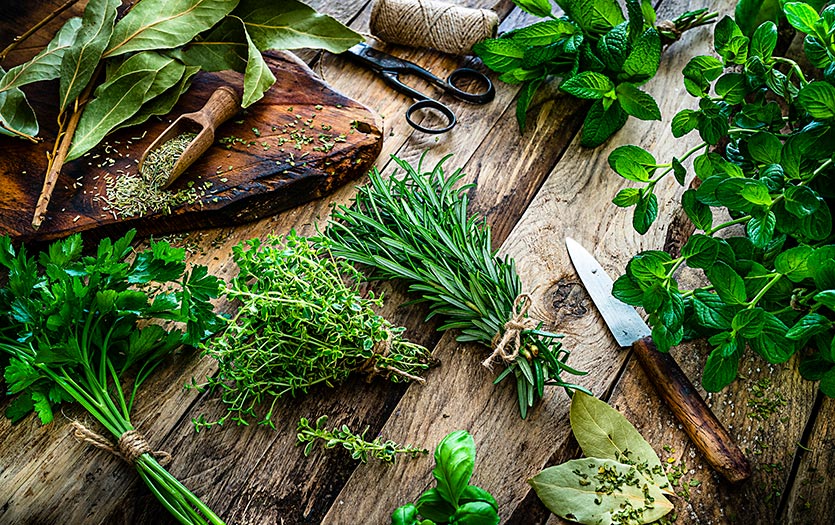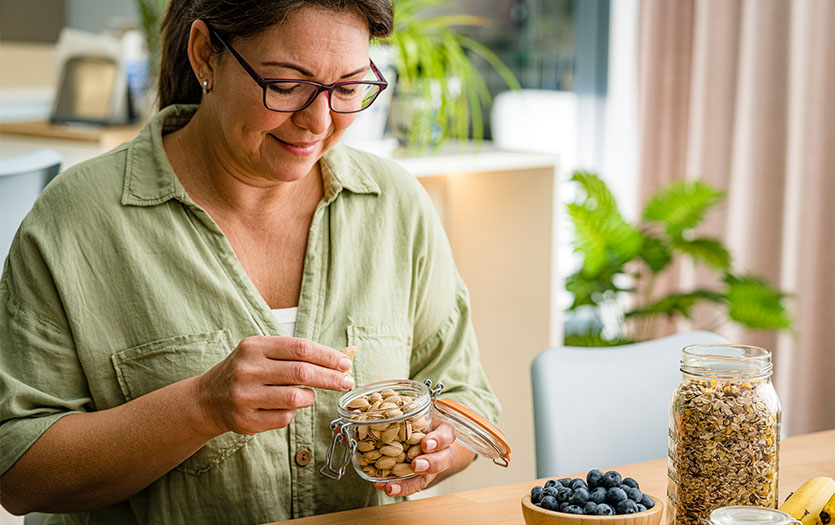
This post was written based on a presentation by Kristen Canan-Smith, greenhouse technician, Charlotte Wehr, greenhouse technician, Rachel Stohlman, RDN, LD, community outreach dietitian, and Kelly Snyder, creative rehab specialist.
You may be familiar with the herbs that you use in the kitchen to enhance the flavor of your meals, but did you know that many herbs also have powerful health benefits? Here, we’ll dive into the world of these natural standouts, including the redeeming qualities of herbal teas and how to grow and harvest your own.
What are herbs?
Herbs are the green, leafy parts of a widespread group of plants that are fragrant or aromatic. Because different herbs have strong smells, tastes and/or therapeutic properties, they are often used for cooking, medicinal purposes, in fragrances and more. Examples of popular herbs include:
- Basil
- Oregano
- Thyme
- Rosemary
- Parsley
- Mint
- Cilantro
The benefits of herbs
Before they were utilized for cooking, many herbs were valued for their medicinal properties. We know that, when used properly, some herbs add therapeutic value to food, including antioxidants and phytochemicals. Antioxidants are critical to your body’s ability to stop cell damage from free radicals, which can prevent medical conditions like some cancers, Alzheimer’s disease, some arthritis-related conditions and more. Phytochemicals have the potential to decrease inflammation in your body, which is a primary cause of chronic disease, cancer cell growth, DNA damage and more.
Many herbs also have as many nutrients as green, leafy vegetables, with large amounts of vitamins A, C and K, which play an important role in helping wounds heal, ensuring healthy growth and development, and keeping your immune system, organs, eyes, muscles and bones healthy.
Healthy herbal teas
Herbal teas offer many different health benefits, from aiding in healthy digestion to anti-inflammatory properties to relaxing muscles to boosting immunity and more. Some of the healthiest herbal teas with healing properties include:
- Chamomile
- Calendula
- Lavender
- Lemon balm
- Rosemary
- Mint
- Hibiscus
- Viola
- Signet marigold
When consuming tea, keep these best practices in mind to get the most benefits:
- Consider the cut. For leaf-based teas, make sure you are seeing more of the leaf in the tea mixture than stems. The finer cut of the leaf allows for more surface area to be exposed, allowing you to get the most health benefits.
- Consider the quality. You should always be aware of where the herbs in your tea are being grown. A lot of herbal tea brands are grown outside of the U.S., which means less control over pesticides and soil contaminants.
- Steep correctly. The longer you allow the leaves to steep, the more nutritional components will be extracted from the leaf. Make sure you cover the steeping tea leaves. Some herbs are considered aromatics, and covering the tea helps keep the oils in the herbs from evaporating during the steeping process. For best results, pour one cup of boiled water over your herbs (1 teaspoon. dried herbs or 1 tablespoon fresh herbs), cover and steep for five to ten minutes.
- Share with your provider. If you are consuming herbal teas on a regular basis, be sure to share that information with your provider as some teas can affect certain medications. Herbal teas should be used with caution during pregnancy, lactation and with small children.
Herbs in your garden
If you have an outdoor, tower or container garden, consider growing your own herbs so they’re readily available for use in cooking or teas. Although most herbs are good choices for a garden, some easy herbs to grow include:
- Basil
- Rosemary
- Oregano
- Lavender
- Parsley
- Sage
- Thyme
- Chives
- Mint
- Cilantro
- Dill
These herbs are low maintenance, don’t require a ton of sunlight or nutrients to grow and will thrive in whatever limited space you give them. Even if you live in an apartment or condo, you can grow your own herbs in a small planter box in a sunny kitchen window or balcony. You can also harvest from most herb plants over and over, making them a great choice to get a lot out of your efforts. And some herbs even repel insects!
When you’re ready to harvest, follow these tips:
- Don’t cut more than 1/3 of your plant.
- Cut at an angle, not straight across.
- Use sanitized scissors or shears.
- For basil, mint, lemon balm, oregano and thyme, be sure to cut above the leaf node.
- For sage, leaf fennel, parsley, cilantro and rosemary, harvest individual leaves or leaf fronds of the oldest leaves.
- For viola, signet marigold, lavender, chamomile and calendula, harvest the flowers.
To dry herbs that you’ve harvested:
- Wash and pat the herbs dry.
- Line a cookie sheet with parchment paper and place the herbs on top.
- Place in an open oven at 180°F for two to four hours.
Now that you know all about the benefits of herbs, be sure to consider adding them into your diet with cooking or teas! And always talk with your healthcare provider if you have any concerns.



